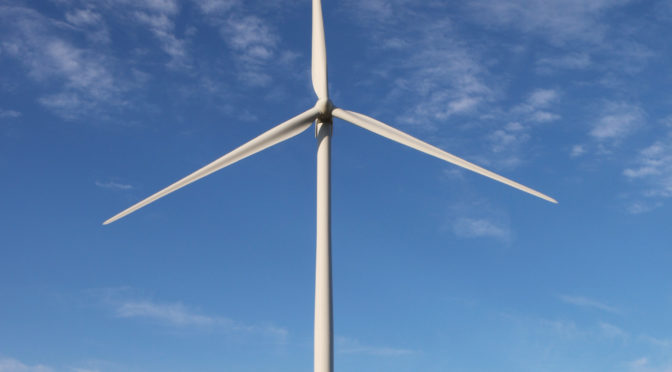Wind turbine curtailment is a hot topic because it can have implications for bird and bat conservation while also impacting wind project economics. Curtailment involves stopping wind turbines at certain times or under certain conditions to reduce the likelihood of collisions with protected or at-risk species – primarily bats, but also some raptors.
The U.S. wind industry estimates that voluntary wind turbine curtailments aimed at reducing or eliminating impacts to bats can result in annual wind energy production losses of up to 5 percent, and sometimes more. As a result, there’s significant demand for curtailment solutions that achieve a balance between clean energy production and conservation. The Wind Wildlife Research Fund (Fund) is supporting new research that can help provide these solutions.
What is curtailment?
The idea of stopping turbines to reduce bat fatalities was first proposed in the early 2000s. It was based on field observations that bats are more active during periods of low wind speeds. It was hypothesized that raising the “cut-in” wind speed (the speed at which turbine blades begin to spin and generate electricity) would reduce bat collisions – a high priority both for wind companies and conservationists.
The problem is, turning off turbines means less clean, carbon-free energy is produced. That means the overall conservation benefit wind energy is reduced (more carbon producing generation must continue), as is the overall economic success of wind energy. In addition, to get more conservation benefit, operators are generally asked to increase the cut-in speed even more, resulting in even more economic loses for wind projects. As a result, the potential economic costs of “blanket” curtailment – curtailment that occurs indiscriminately whenever bats might be active below a set cut-in wind speed – quickly becomes non-viable. The search was on for smarter solutions using algorithms or even artificial intelligence to identify the times and conditions when curtailment will protect bats while minimizing power production losses.
Where we go next
Enter “smart” curtailment – curtailment based on several factors, including wind speed, meteorological conditions, and season.
“Smart curtailment can offer the best of both worlds,” explained Christi Calabrese, EDP Renewables. “We absolutely want to protect wildlife, but if wind energy is going to meet goals to decarbonize the electric grid, we need to optimize curtailment such that wind energy production and project economics remain viable.”
Several efforts are underway to improve smart curtailment solutions, but they all hinge on a central question: what is the optimal cut-in wind speed that protects wildlife and maximizes clean energy production? This focus has highlighted the need for statistical analysis of the information that’s available about the relative effectiveness of different cut-in speeds.
New efforts show promise
To answer this and other questions, in 2019, 30 companies joined the Wind Wildlife Research Fund, a unique industry-led initiative managed by the American Wind Wildlife Institute (AWWI) that pools resources to advance critical collaborative research on wind-wildlife interactions and solutions.
“The Fund is a first-of-its-kind opportunity to pool financial support, scientific knowledge, technical expertise, and innovative thinking to produce scientifically robust solutions,” said Kristen Goland from Avangrid Renewables and Vice Chair of the Fund. “The information that results from these research projects will be extremely valuable. This knowledge base is intended to reduce risk, provide for increased certainty, and improve profitability, in addition to helping conservation goals.”
The Fund’s 2019 research projects are underway, with initial results expected late this year. Importantly, one of the projects is addressing the central question about optimal cut-in wind speed by assessing whether curtailment at a wind speed of 6.9 m/s results in significantly fewer fatalities than a slower cut-in speed of 5 m/s for certain species such as Indiana Bats.
The answer could literally be worth hundreds of millions of dollars annually for American wind power. The working estimate in the industry is that a cut-in speed of 6.9 m/s results in production losses at least four times greater than loses associated with 5.0 m/s cut-in speeds. In the highly competitive energy markets, that’s a huge difference.
The project is focused on analyzing a robust data set of results of curtailment studies. The data is stored in the American Wind Wildlife Information Center (AWWIC), a database containing public and confidential data representing the most comprehensive collection of post-construction fatality monitoring data for onshore wind farms in the U.S.
This study will complement the results of a related Fund research project that is looking at the feasibility of using regional-based weather to predict bat activity and collision risk. Rather than“blanket” curtailment where wind turbines are curtailed at all times bats could be present, they are only curtailed when certain environmental conditions indicate they are at risk of collision. These projects are just two examples of how the Fund is delivering returns to its investors. The full list of 2019 projects is available here, and Fund leaders are working to identify the next group of priority research projects to begin in 2020.
To learn more about the state of the “smart” curtailment science and the Wind Wildlife Research Fund, contact AWWI Executive Director Abby Arnold: [email protected].


